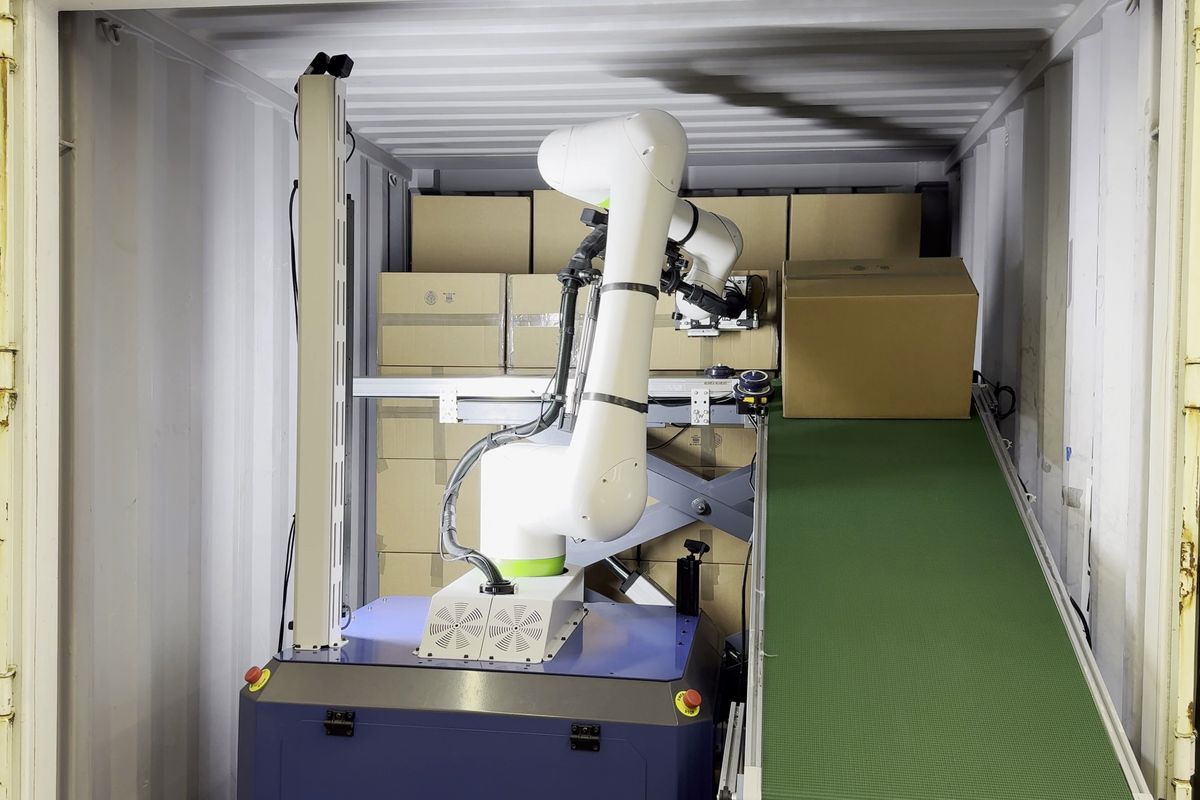You’ve seen this before: a truck-unloading robot that’s made up of a mobile base with an arm on it that drives up into the back of a trailer and then uses suction to grab stacked boxes and put them onto a conveyor belt. We’ve written about a couple of the companies doing this, and there are even more out there. It’s easy to understand why—trailer unloading involves a fairly structured and controlled environment with a very repetitive task, it’s a hard job that sucks for humans, and there’s an enormous amount of demand.
While it’s likely true that there’s enough room for a whole bunch of different robotics companies in the trailer-unloading space, a given customer is probably going to only pick one, and they’re going to pick the one that offers the right combination of safety, capability, and cost. Anyware Robotics thinks they have that mix, aided by a box-handling solution that is both very clever and so obvious that I’m wondering why I didn’t think of it myself.
The overall design of Pixmo itself is fairly standard as far as trailer-unloading robots go, but some of the details are interesting. We’re told that Pixmo is the only trailer-unloading system that integrates a heavy-payload collaborative arm, actually a fairly new commercial arm from Fanuc. This means that Anyware Robotics doesn’t have to faff about with their own hardware, and also that their robot is arguably safer, being ISO-certified safe to work directly with people. The base is custom, but Anyware is contracting it out to a big robotics original equipment manufacturer.
“We’ve put a lot of effort into making sure that most of the components of our robot are off-the-shelf,” cofounder and CEO Thomas Tang tells us. “There are already so many mature and cost-efficient suppliers that we want to offload the supply chain, the certification, the reliability testing onto someone else’s shoulders.” And while there are a selection of automated mobile robots (AMRs) out there that seem like they could get the job done, the problem is that they’re all designed for flat surfaces, and getting into and out of the back of the trailer often involves a short, steep ramp, hence the need for a design just for them. Even with the custom base, Tang says that Pixmo is very cost efficient, and the company predicts that it will be approximately one-third the cost of other solutions with a payback of about 24 months.
But here’s the really clever bit:
Anyware Robotics Pixmo Trailer Unloading
That conveyor system in front of the boxes is an add-on that’s used in support of Pixmo. There are two benefits here: First, having the conveyor add-on aligned with the base of a box minimizes the amount of lifting that Pixmo has to do. This allows Pixmo to handle boxes of up to 65 pounds with a lift-and-slide technique, putting it at the top end of a trailer-unloading robot payload. And the second benefit is that the add-on system decreases the distance that Pixmo has to move the box to just about as small as it can possibly be, eliminating the need for the arm to rotate around to place a box on a conveyor next to or behind itself. Lowering this cycle time means that Pixmo can achieve a throughput of up to 1,000 boxes per hour—about one box every 4 seconds, which the Internet suggests is quite fast, even for a professional human. Anyware Robotics is introducing this add-on system at the MODEX manufacturing and supply-chain show next week, and the company has a patent pending on the idea.
This seems like such a simple, useful idea that I asked Tang why they were the first ones to come up with it. “In robotics startups, there tends to be a legacy mind-set issue,” Tang told me. “When people have been working on robot arms for so many years, we just think about how to use robot arms to solve everything. That’s maybe the reason why other companies didn’t come up with this solution.” Tang says that Anyware started with much more complicated add-on designs before finding this solution. “Usually it’s the most simple solution that has the most trial and error behind it.”
Anyware Robotics is focused on trailer unloading for now, but Pixmo could easily be adapted for palletizing and depalletizing or somewhat less easily for other warehouse tasks like order picking or machine tending. But why stop there? A mobile manipulator can (theoretically) do it all (almost), and that’s exactly what Tang wants:
In our long-term vision, we believe that the future will have two different types of general-purpose robots. In one direction is the humanoid form, which is a really flexible solution for jobs where you want to replace a human. But there are so many jobs that are just not reasonable for a human body to do. So we believe there should be another form of general-purpose robot, which is designed for industrial tasks. Our design philosophy is in that direction—it’s also general purpose, but for industrial applications.
At just over one year old, Anyware has already managed to complete a pilot program (and convert it to a purchase order). They’re currently in the middle of several other pilot programs with leading third-party logistics providers, and they expect to spend the next several months focusing on productization with the goal of releasing the first commercial version of Pixmo by July of this year.
- A Robot for the Worst Job in the Warehouse ›
- No Human Can Match This High-Speed Box-Unloading Robot Named After a Pickle ›
Evan Ackerman is a senior editor at IEEE Spectrum. Since 2007, he has written over 6,000 articles on robotics and technology. He has a degree in Martian geology and is excellent at playing bagpipes.



